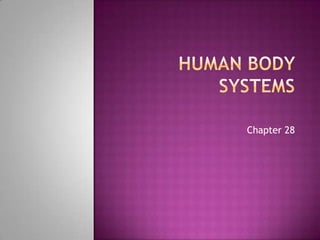
Human body systems
- 1. Chapter 28
- 2. Cells make tissues Tissues make Organs Organs make Organ Systems Organ Systems make an organism
- 3. The Digestive System: The Respiratory System: Smooth muscle cells Epithelial lung cells make: make: Intestinal muscle Epithelial lung tissues, tissues, which make: which make: Intestines, which are Lungs, which are part part of the: of the: Digestive system Respiratory system
- 4. Epithelial tissue– tightly packed cells that line organs and make the skin Connective Tissue—support, bind together, and protect tissues and organs. Tendons, ligaments, bone and cartilage are connective tissues Muscle Tissue—produces movement. Skeletal, cardiac, and smooth muscle Nervous Tissue—transmits and receives impulses
- 5. Circulatory—heart, blood vessels, blood lymph nodes, lymphatic vessels. Transports oxygen, nutrients, and wastes; regulates body temperature. Digestive—mouth, pharynx, esophagus, stomach, intestines, pancreas, gallbladder, liver. Breaks down /absorbs nutrients, salts, water; rids of waste Endocrine—hypothalamus, pituitary, thyroid, parathyroid, adrenals, pancreas, ovaries, testes. Growth, development, metabolism, maintains homeostasis
- 6. Immune—white blood cells, thymus, spleen. Protects against disease, stores and makes white blood cells. Integumentary—skin, hair, nails, sweat and oil glands. Barrier to infection, injury, UV rays, regulates body temperature. Muscular—skeletal,smooth, and cardiac muscles. Produces movement, helps circulate blood and moves food Nervous– brain, spinal cord, peripheral nerves. Processes info., regulates responses
- 7. Reproductive—testes, penis, ovaries, fallopian tubes, uterus, vagina. Produces reproductive cells, houses an embryo Respiratory—nose, sinuses, pharynx, larynx, trachea, lings. Brings in O2, expels CO2 and water vapor Skeletal—bones, cartilage, ligaments, tendons. Supports and protects organs, movement, stores nutrients, makes red blood cells. Excretory—skin, lungs, kidneys, bladder. Eliminates waste, helps maintain homeostasis
- 8. Allparts of the body are controlled by feedback loops. Negative feedback keeps things at set points (ex. body temperature, blood glucose level, oxygen levels) Positive feedback moves AWAY from a set point (ex. clotting factors will increase greatly until a cut stops bleeding, hormones levels are greatly increased during puberty)